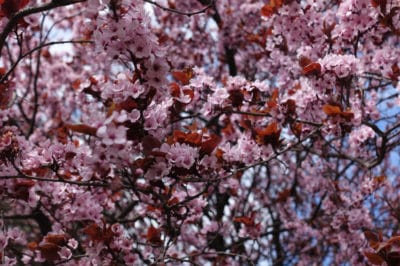Characteristics of Purple Leaf Plum Hedge
This small species of plum tree can be grown into a thick hedge of dense, red or purple foliage, making it a popular choice as a landscaping plant in zones 3 to 8 where it grows best.
Leaves are approximately 3 inches (7.6cm) long with a pointy tip and small serrations along the edges. The color ranges from bright to dark red or purple throughout the growing season, although the leaves can turn green if the plant is growing in shade.
The shrub blossoms with small, fragrant flowers in mid-spring, followed by modest crops of small, but edible, fruit in the fall.
This hardy plum species grows to a height of approximately 8 feet (2.8 meters), and plants can be spaced 2 to 3 feet (.6 to .9 meters) apart to produce a tightly growing hedge structure.
Known by its scientific name as Prunus cisena, and also called cistena plum, this species is drought-tolerant and can survive with little maintenance and in variety of soil types.
Growing Purple Leaf Plum Hedge
Plant in full-sun, if possible, but this shrub will also grow in partial shade. As long as the soil drains fairly well, purple leaf plum hedge does fine in soils ranging from clay to sandy to loam.
Plant in blocks in the ground or in planter boxes when growing as a hedge. Leaves and flowers have more color when the plants are located in an area with maximum sunlight.
This species is both slow-growing and short-lived, being susceptible to a variety of diseases and pests. To reduce disease and pest problems:
- Do not plant where old plum trees were planted in the past.
- Plant in fertile soil, or amend the soil with compost so the plants grow vigorously.
- Water with a drip system to keep foliage from getting wet and spreading disease organisms.
- Prune-out dead, damaged, and diseases branches as soon as you see them.
- Rake up fallen foliage and fruit litter in the fall to reduce habitat for overwintering pests.
While this species is drought-tolerant, it grows more rapidly when given water during warm weather. Faster growth and more foliage keeps the plant healthier and more resistant to pests and diseases.
